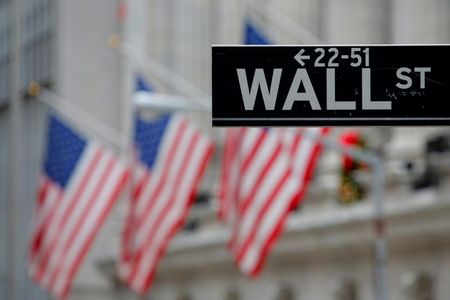By Devik Jain and Sinéad Carew
(Reuters) – Wall Street’s major indexes closed lower on Friday, with the Nasdaq leading the declines as investors bet that a strong jobs report would not slow the Federal Reserve’s withdrawal of support all while they grappled with uncertainty around the Omicron coronavirus variant.
After opening higher, Wall Street spent the rest of the session in the doldrums and an elevated volatility index highlighted investor anxiety.
The Labor Department’s report, ahead of the session’s open, showed that while nonfarm job growth rose less than expected in November, the unemployment rate dropped to 4.2%, its lowest since February 2020, and wages increased.
Separately, a measure of U.S. services industry activity hit a record high in November.
Both sets of data appeared to influence investor expectations for the Fed’s next move towards tightening its policy. Fed Chair Jerome Powell said this week that the central bank will consider a faster wind-down of its bond-buying program, prompting speculation that interest rate hikes would also be brought forward.
“There’s not enough in the jobs report to dissuade the Fed from accelerating the taper and (it) leaves the door open for a quicker rate hike than the market might have been anticipating,” said Steve Sosnick, chief strategist at Interactive Brokers.
On top of this he pointed to concerns that the Omicron variant appeared to be spreading faster than Delta, the last most prevalent version of COVID-19.
The number of countries reporting Omicron cases kept rising on Friday but there was still little clarity on the severity of the disease or the level of protection provided by existing COVID-19 vaccines.
The Dow Jones Industrial Average fell 59.71 points, or 0.17%, to 34,580.08, the S&P 500 lost 38.67 points, or 0.84%, to 4,538.43 and the Nasdaq Composite dropped 295.85 points, or 1.92%, to 15,085.47.
The S&P, the Dow and the Nasdaq all registered declines for a week in which they swung wildly from day to day as investors reacted to Omicron news and Powell’s comments.
The S&P’s decline of 1.2% was its second weekly decline in a row while the Nasdaq fell 2.62%, also its second straight week of losses. The Dow dropped 0.92% in its fourth consecutive weekly decline.
In a clear indication of investor nerves, Wall Street’s fear gauge, the CBOE Market Volatility index, went above 35, in afternoon trading, for the first time since late January. It pared some gains however to close up 9.7 points at 30.67.
Meanwhile the S&P sector outperformers were defensive sectors consumer staples, closing up 1.4% and utilities, adding 1%, followed by healthcare, which climbed 0.25%.
By the end of the session, consumer discretionary, down 1.8%, was the biggest loser, followed by technology, which fell 1.65%.
Decliners included heavyweights such as Tesla, down 6%, and Nvidia, down 4% and both Apple Inc and Microsoft losing more than 1%.
“It’s hard to argue that stocks with such huge valuations are defensive,” said Interactive Brokers’ Sosnick.
And with large cap technology stocks having avoided a recent deterioration in the broader markets, Sosnick said: “That’s catching up to those stocks.”
The economically sensitive Dow fell less than its peers during the session while other cyclical sectors like industrials, materials also outperformed.
DocuSign Inc closed down 42% after the electronic signature solutions firm forecast downbeat fourth-quarter revenue.
Declining issues outnumbered advancing ones on the NYSE by a 2.68-to-1 ratio; on Nasdaq, a 3.39-to-1 ratio favored decliners.
The S&P 500 posted 11 new 52-week highs and six new lows; the Nasdaq Composite recorded 15 new highs and 682 new lows.
On U.S. exchanges 13.8 billion shares changed hands compared with the 11.52 billion average for the last 20 sessions.
(Reporting by Sinéad Carew in New York; Devik Jain, Anisha Sircar and Sruthi Shankar in Bengaluru; Editing by Marguerita Choy and Maju Samuel)









